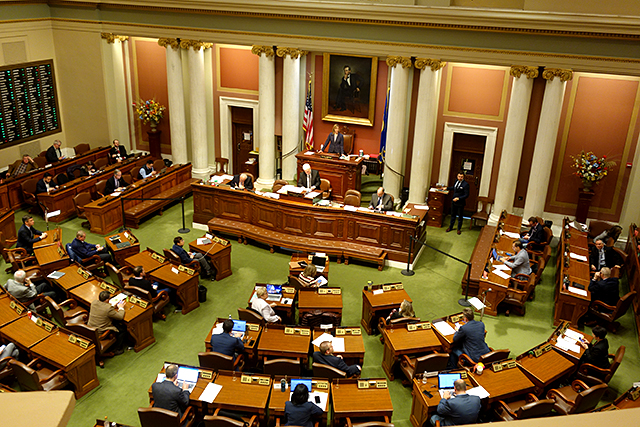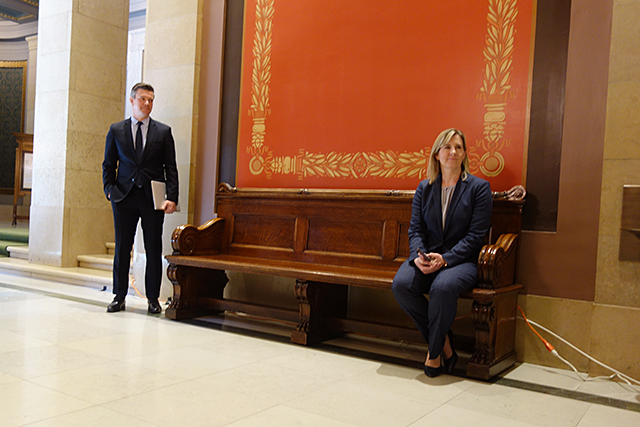The Minnesota Legislature convened — quickly and oddly — to pass a COVID-19 response bill Thursday.
With many House members missing — and the Senate for the first time in state history allowing 15 members to vote by phone — the bill was passed and sent to the governor.
House and Senate leaders had negotiated the package of appropriations with Gov. Tim Walz after holding committee meetings by conference call during the previous week. Then, with just enough House members in the Capitol to suspend normal processes and adopt the bill, they did so. The House passed the bill, House File 4531, on a vote of 99-4 after meeting for just over an hour.
“Members, we have a lot of work to be done,” said House Majority Leader Ryan Winkler after the measure was passed. Once the emergency ebbs, the job will be to help the state “recover, revive and move on.”
The Senate then responded with a 67-0 vote in favor of its version of the bill, after debating for nearly three hours. Amendments were offered but withdrawn before votes were taken.
“Together, we’re all trying to defeat the coronavirus and we’re all trying to make sure we don’t kill all the jobs and livelihoods of Minnesotans,” said Senate Majority Leader Paul Gazelka. “That’s a delicate balance.”
The Nisswa-area Republican noted that the virus was a blip on the February revenue forecast and wasn’t a factor in those estimates.
Once the votes were completed, with the only no votes coming from members of the House New Republican Caucus, the bill was signed by House and Senate presiding officers. Then lawmakers returned to their districts and homes.
Walz praised the work. “Last night, we were late into the evening on the phones together and early this morning,” Walz said. “These are a package of initiatives that will help Minnesota be prepared, will ease the pain of the economic squeeze that’s happened to families, and will put resources in the place they need to be in.”
The bill appropriates $330 million and is the third special appropriation since the specter of COVID-19 first appeared. Previously, the Legislature allocated $21 million to the Minnesota Department of Health and $200 million to state hospitals and other health care services. (Here is a link to the bill and a summary of expenditures.)

[image_credit]MinnPost photo by Peter Callaghan[/image_credit][image_caption]With many House members missing, the bill was passed and sent to the governor.[/image_caption]
It sets aside $11 million — $1 million each — to the state’s 11 American Indian tribes. Some Republicans objected to the relatively lax reporting for use of that money. Sen. Scott Jensen noted that one of the tribes, the Shakopee Mdewakanton Sioux Community, is one of the wealthiest in the U.S. because of its casino operations.
It also codifies some of the changes Walz made to unemployment insurance, including waiving the one-week waiting period for payments to begin.
The legislation took an unusual and opaque path. House committees held conferences by telephone and even broke into partisan groups so as not to trigger the open meetings law that applies to the Legislature. Some members complained that they didn’t receive a draft until 6 a.m. Thursday and even that changed before the bill was posted, ten minutes before the House took it up.
That also led to confusion. One omission was a special $500 grant to each family on the Family Investment Program, the state’s primary welfare payment. It came out of the bill so late that the lead negotiator on that program thought it was still in when the Senate debated the bill.
“I was told it was there,” said Sen. Jim Abeler, R-Anoka, the chair of the Senate Human Services Finance Committee, telling Sen. Jeff Hayden he would cosponsor a bill with him when the Legislature returns.
Also removed was a section to categorize any COVID-19 illness contracted by a first responder as a workplace injury covered by workers compensation and disability coverage. Gazelka said there is a standard to make changes regarding workers compensation only when a business-labor advisory council agrees to those changes, and the council didn’t support this change.

[image_credit]MinnPost photo by Peter Callaghan[/image_credit][image_caption]Senate Majority Leader Paul Gazelka, upper left: “Together, we’re all trying to defeat the coronavirus and we’re all trying to make sure we don’t kill all the jobs and livelihoods of Minnesotans.”[/image_caption]
“As soon as we can be closer than six feet from each other, I’d be happy to talk to you about it,” Pratt said. And Sen. Carla Nelson, R-Rochester, added later: “We’ll get through this together. We’ll just do this six feet apart.”
There are some non-financial initiatives in the bill. In addition to codifying some of the sections of Walz executive orders, the measure gives the state authority to move prisoners in order to slow or prevent the spread of COVID-19. “When the remaining term of imprisonment for a convicted person upon commitment is 90 days or less, the commissioner of corrections may contract with a county for placement of the person in a county jail or detention center for the remainder of the person’s term.”
It also allows essential workers who require background checks to be cleared before fingerprint results are available, though other aspects of the background check would still need to be completed.
Before leaving, the House also approved new joint rules that will allow them to hold future emergency sessions with remote attendance and voting, something not allowed under the old rules.
The speed of the crisis made the response unusual. One month ago, the state had a $1.5 billion surplus and a $1.86 billion rainy day fund. Budget writers projected that both will be gone over the course of the next two years thanks to the coronavirus and the state’s response.

[image_credit]MinnPost photo by Peter Callaghan[/image_credit][image_caption]Majority Leader Ryan Winkler and Speaker Melissa Hortman practicing social distancing following the vote in the Minnesota House.[/image_caption]
He noted that in the last 10 days the use of the unemployment fund has tripled. “As we move forward we will be making exceptionally difficult choices, choices the public will not like, choices that we will not like,” he said. “But as has been demonstrated with this crisis, proactive, strong, preventative leadership on the front side can lead to enormous benefits.”
House Minority Leader Kurt Daudt said lawmakers must soon begin looking to reduce discretionary spending. “Members, please be aware that money does not grow on trees around here and we need to be very cautious and watch every dollar we spend,” Daudt said. “So we don’t make the problem next year that we will all have to face even greater.”
MinnPost reporter Walker Orenstein contributed to this story.






Appears to be a 200 million dollar slush fund for Walz. 11 million for the casinos? Once again the taxpayers are forking over hundreds of millions for those who live off the welfare state.
So the commissioner only needs to submit a request before the committee if it’s over 1 million. And they didn’t make the committee evenly split among both parties, the majority are Democrats. Since they only need a majority to approve then there’s no chance any spending will be denied.
Any bets on the balance of this fund come 11pm May 10th? I’ll bet it’ll be very close to 0.
Thankfully we have not unwisely spent (or refunded) our MN rainy day fund of $1.8B.
State governments have socked away more than $72B in reserve funds compared to just $33B prior to the 2008 recession. However, not all states are equal in this regard.
NY – whose state expenditures are 3 times the size of MN – has been clamoring for bailout funds. They have reserved only just over $2B at the end of the last fiscal year, a little more than a third of their authorized levels and just 2.5% of expenditures.
For comparison’s sake, Texas’s Rainy Day reserve funds (as % of expenditures) are estimated at 19.7 percent, California’s at 16.7 percent, Michigan’s at 10 percent, Florida’s at 4.4 percent and Minnesota’s at 9.3 percent.
Well, one thing you can say about the COVID catastrophe, it definitely shows the idiocy of MN Repubs’ monotonous clamoring to “return the people’s money!” (i.e cut taxes) every time the state reports a budget surplus/rainy day fund of any size. We heard Repubs blathering this tired and self-defeating slogan exactly one month ago.
The entire goal of rational public finance is to set tax rates such that they can remain constant and predictable, so that surpluses can build up in prosperous times, ready for use in economic downturns. But such mid-level college economics coursework seems beyond “conservative” understanding…